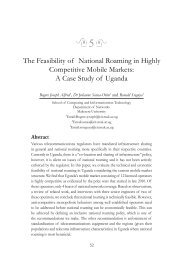Benjamin Kanagwa, Joab Agaba, Doreen Tuheirwe and Susan ...
Benjamin Kanagwa, Joab Agaba, Doreen Tuheirwe and Susan ...
Benjamin Kanagwa, Joab Agaba, Doreen Tuheirwe and Susan ...
You also want an ePaper? Increase the reach of your titles
YUMPU automatically turns print PDFs into web optimized ePapers that Google loves.
Introduction<br />
Body<br />
Application<br />
Part 6: Improving Learning objects reusability through automatic generation web services 507<br />
Which introduces the learner to the content presented in the LO. This<br />
could be a simple page that gives a summary about the LO.<br />
Which is the actual content of the LO for the learning process. Here<br />
the content presented in the body of the LO largely depends on the<br />
pedagogical method used by the designer. For example, the designer<br />
might choose to divide it into three parts namely; Engagement,<br />
Apprehension <strong>and</strong> Comprehension<br />
which is where the learner applies the knowledge gained from the<br />
LO, say, through a quiz<br />
Similar to learning objects, a key component of web services is how they are described.<br />
Web services are generally described by an XML description document, expressed in the<br />
Web Service Description Language (WSDL). Given then that both LOM <strong>and</strong> WSDL<br />
are XML documents, the transformation process reduces to defi nition of mapping<br />
between the elements in the different documents.<br />
Transformation rules<br />
The transformation of LOM to WSDL is supported by the commonality of tags. The<br />
table below shows the LOM elements (also known as tags) , <strong>and</strong> their corresponding<br />
WSDL component transformations. To enable quick searching, some of the description<br />
elements are mapped onto operations. For instance, the General.Language tag can be<br />
mapped to both the Defi nition.Documentation tag as well as new operation called<br />
getLanguage() that can be called on the service. As a convention, the dot notation is<br />
used to denote nested tag elements.<br />
LOM WSDL<br />
General<br />
General.Defi nitions Defi nitions<br />
General.Identifi er (a globally unique label<br />
that identifi es this LO)<br />
-Targetnamespace = uri<br />
General.Language (the primary human<br />
language used within this LO to<br />
communicate to the intended user)<br />
-Defi nition.Documentation<br />
-portType.Operation= getLanguage()<br />
General.Description (a textual description of<br />
the content of this LO)<br />
-Defi nition.Documentation<br />
Metadata (describes the metadata record -Message (an abstract, typed defi nition<br />
itself rather than the LO)<br />
of the data being communicated.)<br />
Technical (describes technical requirements<br />
<strong>and</strong> characteristics of the LO)<br />
Technical.Format (technical datatypes of this<br />
LO)<br />
Binding (a concrete protocol <strong>and</strong> data<br />
format specifi cation for a particular<br />
port type.)<br />
Types (a container for data type<br />
defi nitions using some type system<br />
(such as XSD).)
















